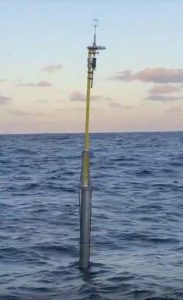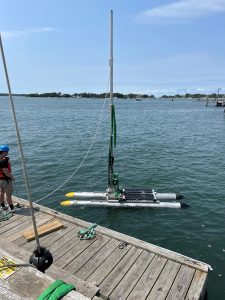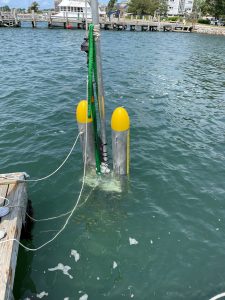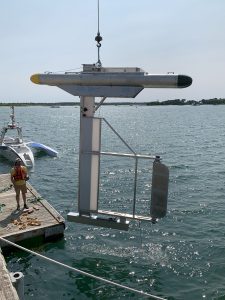Research Projects
Synopses of my present research projects are given below.

Ice-Tethered Profiler/Arctic Observing Network
JMT + R. Krishfield, J. O'Brien, S. Cole and A. Proshutinsky
Recent studies indicate that the Arctic may be both a sensitive indicator and an active agent of climate variability and change. While progress has been made in building understanding the Arctic's coupled atmosphere-ice-ocean system, full comprehension of its evolution has been hindered by a lack of data, particularly of the ocean below sea ice. This observational gap represents a critical shortcoming of the ‘global’ ocean observing system. Addressing this gap, a new instrument, the ‘Ice-Tethered Profiler’ (ITP) was conceived to repeatedly sample the properties of the ice-covered Arctic Ocean at high vertical and temporal resolution over extended time periods. Analogous to the international Argo float program that is employing autonomous profiling floats to return real-time seawater property data from the temperate and tropical oceans, under funding provided from the U.S. National Science Foundation's Arctic Observing Network (AON) program, The Woods Hole Oceanographic Institution ITP program is working together with fellow North American, European and Asian investigators to maintain an array of ITPs and other similar instruments throughout the ice-covered Arctic. It is hoped that the analysis of data from these instruments will lead to better appreciation of the Arctic Ocean's response to, and role in, global climate change.
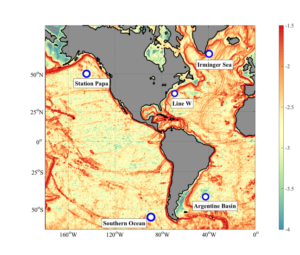
Map showing the locations of the OOI Global measurement sites and that of the Line W study, with background colors indicating the logarithm of bottom topographic slopes over 1/3 degree. After LaCasce (2017).
Quantifying internal wave and mesoscale variability using Ocean Observatory Initiative data
JMT + R. Musgrave (WHOI/Dalhousie)
This is a joint data-analysis/process-modeling study to investigate mesoscale and internal wave variability and the relationships between them. The observations to be examined derive from the four Global sites of the Ocean Observatory Initiative (OOI), with data from the Line W program augmenting. The modeling work will involve process studies and analysis of output from a very-high-resolution global simulation. The research will contribute to understanding ocean mixing processes and their parameterization in climate models. While the horizontal resolution of global numerical climate models has increased dramatically over the last 30 years, turbulent diabatic processes in such simulations must still be parameterized (now and into the foreseeable future). For prediction, it isn't appropriate to simply specify turbulent diffusivities but rather, the physical processes responsible for the mixing must be understood, and how the processes vary with ocean conditions must be quantified. It is generally accepted that internal wave breaking supplies the energy responsible for diapycnal mixing in the ocean interior. How and where internal waves are generated, how they propagate horizontally and vertically, and how they dissipate are active areas of research at present. All appear to be influenced by the sign, magnitude and spatial distribution of the ocean's mesoscale vorticity field. With their enhanced resolution, many current climate models are now mesoscale eddy permitting with some arguably able to be characterized as eddy resolving. That a model exhibits eddy variability is however no guarantee that the simulated motions have realistic properties, in particular a realistic vertical structure (which can be influenced by bottom slope/roughness). This study will explore multi-year deep-ocean time series of ocean currents and stratification from several geographic regions, complemented with numerical modeling work, to document the characteristics of the internal wave and mesoscale eddy variability and explore the physical processes controlling them. Improved representation of mixing processes in climate models is a long-term goal.
X-Spar - the Expendable Free-Drifting Spar Buoy
C. Clayson, J. Edson and JMT
The exchanges of heat, moisture, and momentum between the ocean and atmosphere play a critical role in earth's climate system. These energy exchanges drive both ocean and atmospheric circulations. Current in situ observations are simply not adequate to accurately evaluate atmosphere-ocean exchange, especially at the weather scales, and not sufficient in many locations, such as the high-latitudes, to even constrain models and satellite observations. In particular, air-sea interaction in Southern Ocean is poorly understood owing to very limited observations. Addressing this shortcoming in the global environment observing system, Clayson and Toole conceived and oversaw development of a freely-drifting spar buoy instrument system to return near-surface meteorological and oceanographic observations over time periods of a year or longer. (Spar buoys are long, thin structures that float vertically in the ocean spanning the air-sea interface. Owing to their small cross-sectional area, spar buoys tend not to heave vertically with smaller-scale waves, making them ideal platforms for boundary layer meteorological observations, particularly direct covariance flux estimates.) Being relatively low-cost and because all data are telemetered ashore, the system may be considered expendable: hence the device's name "X‑Spar." With WHOI funding and support from Eastman Chemical, Inc., a prototype system was built and deployed for a short-term test (photograph shows the X-Spar being deployed). Currently with ONR support, X-Spar 2.0 is being constructed for possible use south of Iceland in the NISKINE DRI. The system may also be used in support of the ATOMIC study in the western, low-latitude North Atlantic.
SSB - the Sailing Spar Buoy
JMT, G. Packard, T. Lanagan, S. Faluotico, C. Roman (URI), D. Casagrande (URI)
Building on the X-Spar concept but without the "X", the Sailing Spar Buoy now under development will be staged in a convenient port, sail itself to a designated study region, convert to a spar for making air-sea interaction observations, and at mission end, transition back to a sailing vessel for return to port, sensor recalibration and refurbishment.
A scale model of the SSB has been built and is now undergoing performance assessments in local waters. Should the model show promise, hopefully a follow on project will see the construction and deployment of the full-sized system.
